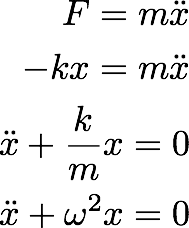We
will be be
starting the Chapter
3:
Oscillations.
Why
oscillations
are important?
Oscillatory
motions can be
found in many
natural as
well as
engineered
systems.
Oscillatory
motion is a
change in a
quantity that
repeats in
regular
intervals.
Examples:
-
Vibration of a
particle
attached to a
string
-
Simple
pendulum
-
Compression of
air in a sound
wave
-
Atomic
vibration in a
crystal
-
Orbit of a
planet about a
star
The
object infact
pass the same
place in
regular
intervals of
time. We
are looking at
the
oscilliation
in the
displacement.
There are
other
oscilliations
which are
important and
useful. One
example is, we
can make a
electrical
circuit such
that the
charge in a
capacitor
change
periodically
in time.
We will study
the properties
of this
oscillations
as a function
of time. One
common thing
in oscillatory
systems is,
they
expereince
resistive
forces
similar to
those we
discussed in
the previous
chapter.
Resistive
forces will
not let the
particle to
continue
motion as we
discussed
above. The
oscillation
amplitude
decreases with
time as a
result of the
resistive or
damping force.
The
oscillation is
damped, and
ultimately
stops the
motion.
In a machine
however, we
want to keep
the
oscillation
continue
without
damping. We
can apply an
external force
to do that. We
can apply a
periodic
external force
or a constant
external
force. We will
discuss how an
external force
effect the
damped
oscillatons.
So the chapter
comes in three
major
sections:
- Simple
Harmonic
Oscillations
- Damped
Harmonic
Oscillations
- Forced
Harmonic
Oscillations
In the next
two lectures,
we will
quatitatively
analyze these
systems using
the Newton's
Laws.
Simple
Harmonic
Osciliations:
When an object
is in an
equilibrium
position, when
you displace
it away from
the
equilibrium
(in a small
displacement),
the particle
tries to
comeback to
the
equilibrium
position. The
force which
puts the
particle back
in the
original
position is
called a
restoring
force.
The restoring
force can take
a complicated
form. It can
be a function
of the
displacement,
instantaneous
velocity etc.
Here we limit
our discussion
for which the
restoring
force is a
function fo
the
displacement:
F=F(x). We can
therefore
expand the
force function
around the
equilibrium
position as:

----------------------
(5.1)
Here,
F0 is the
force at the
equilibrium.
Since it is
the net force
at the
equilibtium,F0
must be equal
to zero. Now,
if we consider
only the small
displacements
x, we can
assume that
all the higher
powers of x
are equal to
zero. So the
total force
from eq. (5.1)
can be written
as:
------------------------
(5.2)
where
we have
substituted,

Hooke's
Law:
Note that,
because the
restoring
force F(x) is
always
directed
towards the
equilibrium
position, the
derivative
dF/dx is
negative, and
the force
constant k is
a positive
constant. This
linear force
behavior is
called the
Hooke's Law.
While in
realistic
problems, the
restoring
force can take
complicated
forms, the
Hooke's law
behavior gives
a reasonable
assumption for
some physical
problems
in
nature.
Now let's
solve the
equation of
motion of the
particle with
a Hook's Law
type restoring
force.

----------------
(5.3)
This
equation has
the solution
of the form:
where
the phases
differ by ¶/2.
This is the
well-known
sinusodial
solution for
the Simple
Harmonic
oscillator.
EXAMPLE:
(Problem 3.7
from Text). A
body of
uniform cross
sectional
area, A=1 cm2
and of mass
density
\rho=0.8 g/cm3
floats in a
liquid of
density 1 g/cm3
and at
equilibrium
displaces a
volume V=0.8
cm3
. Show that
the period of
small
oscilliations
about the
quilibrium
position is
given by:
|

